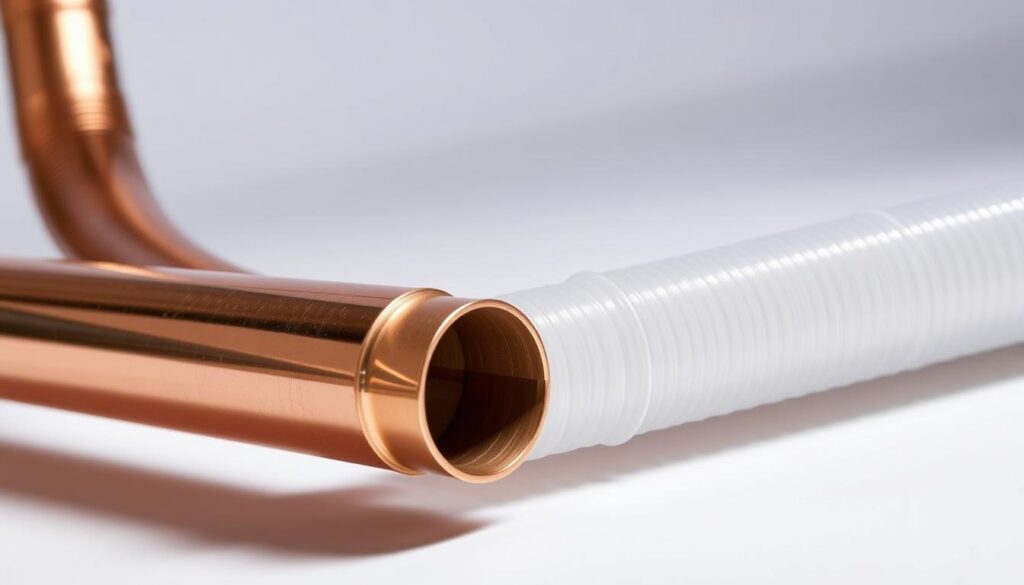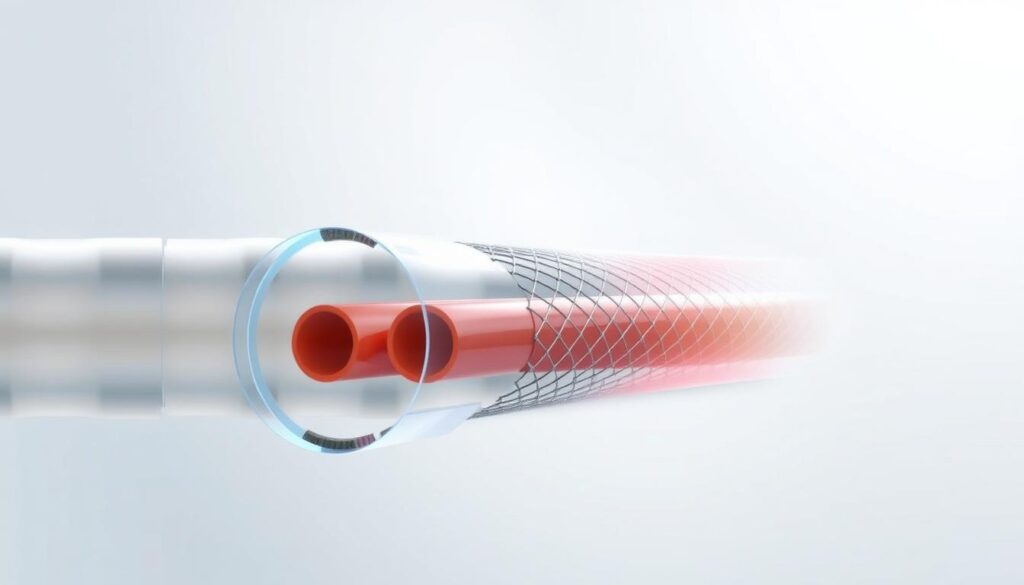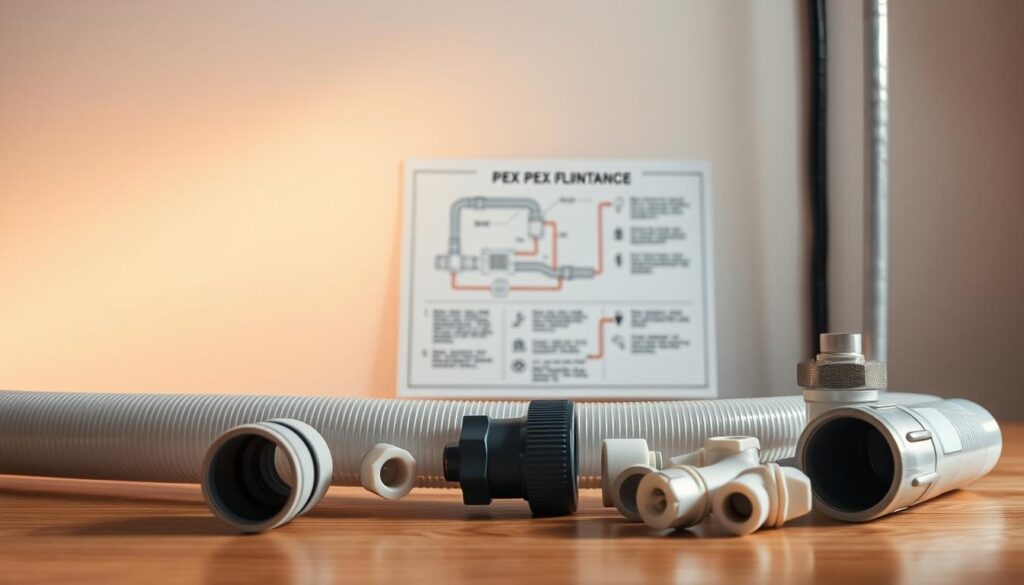Affiliate Disclosure
Plumber Guide Guys is a participant in the Amazon Services LLC Associates Program, an affiliate advertising program designed to provide a means for sites to earn advertising fees by advertising and linking to Amazon.
Is PEX Plumbing Better Than Copper? Did you know over 60% of new homes in the U.S. now use PEX piping? This fact shows how popular PEX plumbing systems are getting. It also raises the question: Is PEX better than traditional copper pipes?

When picking plumbing materials for your home, knowing the differences between PEX and copper can save you money and trouble. Is PEX plumbing better than copper? The answer isn’t simple. But, recent tech advances have made PEX a great choice for many homeowners and contractors.
PEX vs copper pipe durability is a big topic in modern building. This guide will compare them fully, covering costs to long-term performance. Whether you’re renovating or building a new home, you’ll learn what to choose for your plumbing.
Key Takeaways
- PEX piping offers significant cost advantages over copper
- Installation of PEX is faster and more flexible
- Modern PEX systems have improved durability
- Climate and local building codes impact material selection
- Professional consultation is recommended for specific projects
Table of Contents
Understanding PEX Plumbing: History and Evolution
PEX plumbing has changed how we handle water systems at home. It started small but now leads in home building. This new tech has made plumbing better for everyone.
The Birth of PEX Technology
In 1968, German scientist Thomas Engel created cross-linked polyethylene (PEX). This material was flexible and strong, unlike old copper pipes. Soon, experts and plumbers were all about it for better solutions.
Development from 1968 to Present
PEX plumbing has come a long way. Here are some big moments:
- 1980s: It arrived in the United States
- It was first used in radiant floor heating
- It quickly became popular in homes
Modern Applications in Home Plumbing
Now, PEX is used in over 60 percent of new home water systems. It’s loved for many reasons:
- It’s easier to install than copper pipes
- It’s cheaper to make
- It withstands freezing and corrosion well
- It’s flexible for different designs
PEX has made installing pipes much simpler. This is why it’s the top choice for new buildings.
Is PEX Plumbing Better Than Copper? A Detailed Comparison
Choosing between PEX and copper plumbing is a big decision for homeowners. It affects your home’s plumbing for years to come. So, is PEX plumbing better than copper? It depends on several important factors.
PEX plumbing stands out because of its flexibility. Unlike copper, PEX can bend and fit around obstacles. This makes installation easier and more flexible for different home designs.
- Copper pipe corrosion issues create significant challenges for homeowners
- PEX resists mineral buildup and chemical degradation
- Installation costs for PEX are typically lower than copper
Copper pipes used to be the go-to for homes but have big problems. They corrode easily, which is bad in areas with acidic water or lots of minerals. PEX, on the other hand, is very resistant to these issues.
What you need for your plumbing will decide the best choice. PEX works great in most homes. It offers:
- Lower material costs
- Faster installation
- Greater resistance to freezing
- Reduced risk of leaks
PEX is becoming the modern choice for home plumbing. It’s flexible, durable, and cost-effective. Many homeowners choose it for reliable water systems.
Cost Analysis: PEX vs Copper Installation
Choosing between PEX and copper for plumbing is a big decision. It affects your wallet now and later. Knowing the costs helps homeowners and contractors make smart choices.
Material Costs Breakdown
PEX and copper have different prices. PEX costs between $0.40 and $4 per foot, which is cheaper. Copper, on the other hand, can cost between $2 and $12 per foot.
- PEX pipe: $0.40 – $4 per linear foot
- Copper pipe: $2 – $12 per linear foot
- CPVC pipe: $0.50 – $3 per linear foot
Labor and Installation Expenses
Installation costs add up quickly. PEX is easier to install, which means lower labor costs. This is a big plus compared to copper.
| Material | Material Cost | Installation Time | Labor Cost |
|---|---|---|---|
| PEX | $0.40 – $4/ft | Faster | Lower |
| Copper | $2 – $12/ft | Slower | Higher |
Long-term Financial Benefits
PEX is more than just a cheaper upfront cost. PEX offers significant long-term advantages. It saves on energy bills and has lower maintenance costs.
- Faster installation reduces labor costs
- Better thermal insulation saves energy
- Fewer connections mean reduced leak risks
By looking at the costs of PEX and copper, you can choose wisely. This choice balances today’s costs with tomorrow’s savings.
Durability and Lifespan of PEX Piping
Homeowners often look for plumbing solutions that last long. PEX piping is a strong choice against traditional copper pipes. It offers great longevity and performance.
PEX plumbing can last between 40-50 years. This is better than copper pipes. It has special features that make it durable:
- Exceptional resistance to corrosion
- Superior freeze-damage protection
- Minimal scaling buildup
- Flexibility that reduces stress points
Studies from around the world show PEX’s durability. Countries in Europe have seen PEX pipes last over 30 years. This proves it’s reliable for the long term.
| Durability Factor | PEX Performance | Copper Performance |
|---|---|---|
| Corrosion Resistance | Excellent | Moderate |
| Freeze Damage Tolerance | High | Low |
| Expected Lifespan | 40-50 years | 50-70 years |
PEX is very durable, but it has some limits. UV exposure can damage it. It’s best used indoors or in protected areas. Getting it installed by a pro and following the manufacturer’s advice will help it last longer.
Installation Methods and Requirements for PEX
Installing PEX piping changes the game in home plumbing. It tackles the tough parts of copper pipe installation. PEX is flexible and easy to install, making your plumbing project better.
Essential Tools for PEX Installation
To install PEX piping right, you need special tools. They’re different from what you use for copper pipes:
- PEX crimping tool
- Pipe cutters made for PEX
- Measurement tape
- Tools for tube calibration and deburring
- Expansion rings
Professional vs DIY Installation
PEX stands out when you compare professional and DIY setups. Copper pipes need soldering skills, but PEX is easier for homeowners to handle.
“PEX piping makes complex plumbing jobs easier for homeowners.” – Plumbing Professionals Association
Common Installation Challenges
Even though PEX is simple, it has its own hurdles. Some common issues are:
- Getting connections right
- Keeping bends at the right size
- Shielding pipes from UV rays
- Handling temperature changes
Knowing these challenges and using the right methods can lead to a successful PEX installation. It’s durable and lasts long.
PEX Performance in Various Climate Conditions

Choosing the right plumbing material is key, whether you live in a cold or warm area. PEX piping stands out because it’s flexible. This flexibility is a big plus compared to copper pipes, which can’t stretch.
PEX is great for tough weather. It handles freezing temperatures better than copper. Here’s why:
- PEX expands more than copper, which helps prevent damage.
- It doesn’t crack like copper does in the cold.
- It stays strong even when the temperature changes a lot.
Temperature changes can stress your plumbing system. But PEX flexibility advantages mean you don’t have to worry as much about pipes bursting in winter. Its ability to stretch instead of breaking helps protect your home from water damage.
PEX is also good in hot and cold weather. This makes it a great choice for many places. Areas with big temperature swings will really benefit from PEX’s flexibility.
Professional plumbers often suggest PEX for its excellent weather resistance and lasting quality.
Even though PEX is great in most situations, it has some downsides. Direct sunlight can harm it. So, it’s important to have it installed by a pro and protected well to work its best.
Water Quality and Safety Considerations
Choosing the right plumbing materials is key for homeowners and contractors. The type of piping you pick can greatly affect your water system’s safety and performance.
PEX piping has been tested thoroughly for safety in drinking water. Today’s PEX pipes meet NSF/ANSI Standard 61. This ensures they follow strict health and safety rules.
Chemical Resistance Properties
PEX pipes stand out for their strong resistance to chemicals. This makes them a top choice for water systems. Unlike copper pipes, PEX doesn’t corrode easily, even in different water conditions.
- Resistant to chlorine and water treatment chemicals
- Low risk of chemical leaching
- Keeps water quality steady in various environments
Health and Environmental Impact
Choosing safe materials is vital for clean water. PEX pipes have several benefits:
- Less chance of metal ion contamination
- Little interaction with water chemistry
- Lower environmental impact than metal pipes
Certification Standards
Professional-grade PEX piping meets strict safety standards. Manufacturers must follow detailed testing to ensure pex water quality safety meets or beats regulations.
NSF/ANSI Standard 61 certification is the top mark for water system safety.
Maintenance and Repair Requirements

Knowing how to take care of your home’s plumbing is key. PEX plumbing is easier to maintain than copper pipes, thanks to its resistance to corrosion.
PEX plumbing has a long lifespan, which is a big plus for homeowners. It doesn’t corrode like copper pipes do. This makes PEX pipes last longer and handle environmental challenges better.
- Minimal maintenance requirements
- Resistance to scaling and mineral buildup
- Flexible repair options
- Lower long-term maintenance costs
To keep your PEX plumbing system in top shape, follow these steps:
- Protect pipes from direct sunlight exposure
- Inspect connections periodically
- Ensure proper insulation in extreme temperatures
- Use specialized PEX repair tools for any damage
“PEX pipes offer homeowners a low-maintenance solution that dramatically reduces the risk of long-term plumbing issues.” – Plumbing Professionals Association
Copper pipes can corrode, affecting water quality and system integrity. But PEX is more durable. It resists chemical reactions and environmental stress, so you won’t have to worry as much about pipe damage.
Experts say it’s smart to have your PEX system checked regularly. Knowing how to care for it will help it last longer and work better.
Applications and Limitations of PEX Systems
PEX plumbing systems are great for both homes and businesses. They are flexible and work well in many places. This makes them perfect for any size project.
Looking at the good and bad of PEX shows its strong points. It’s flexible and can be used in many ways.
Residential Implementations
In homes, PEX is very useful:
- Hot and cold water line installations
- Radiant floor heating systems
- Connections to household water-using appliances
- Bathroom and kitchen plumbing renovations
Commercial Applications
Businesses also see the value in PEX plumbing systems. They are good for:
- Office building water distribution
- Institutional facility plumbing
- Light industrial water supply networks
Installation Considerations
But, there are some things to keep in mind:
- Limited outdoor use due to UV sensitivity
- Not recommended for direct sunlight exposure
- Potential restrictions in some local building codes
*PEX represents a flexible, modern solution for contemporary plumbing challenges.*
Think about your project needs before choosing PEX. It might be just what you need.
Conclusion
Choosing the right plumbing material is a big decision. You need to think about your home’s needs, local rules, and the weather. Each material has its own good points and things to watch out for.
PEX pipes are flexible and save money, which is why many people like them. They also don’t freeze easily and are simple to install. On the other hand, copper pipes are strong and reliable. They’ve been trusted by experts for many years.
When deciding, think about your budget, the weather, water quality, and how long the pipes will last. No one solution works for everyone. But knowing the differences between PEX and copper helps you choose wisely. A professional plumber can give advice based on your home’s needs and local rules.
In the end, both PEX and copper are important in plumbing. The important thing is to pick the best material for your home. This ensures good water flow, little upkeep, and lasting performance.

